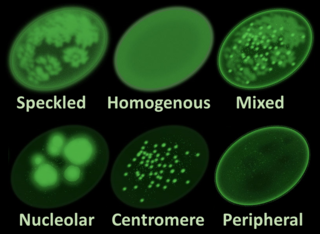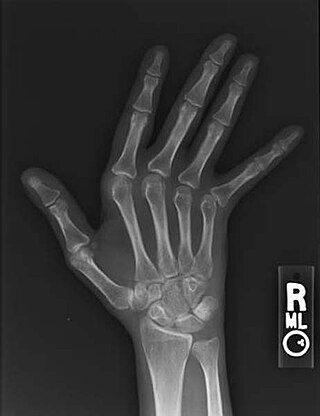
Antinuclear antibodies are autoantibodies that bind to contents of the cell nucleus. In normal individuals, the immune system produces antibodies to foreign proteins (antigens) but not to human proteins (autoantigens). In some cases, antibodies to human antigens are produced.
Libman–Sacks endocarditis is a form of non-bacterial endocarditis that is seen in association with systemic lupus erythematosus, antiphospholipid syndrome, and malignancies. It is one of the most common cardiac manifestations of lupus.

Lupus nephritis is an inflammation of the kidneys caused by systemic lupus erythematosus (SLE), an autoimmune disease. It is a type of glomerulonephritis in which the glomeruli become inflamed. Since it is a result of SLE, this type of glomerulonephritis is said to be secondary, and has a different pattern and outcome from conditions with a primary cause originating in the kidney. The diagnosis of lupus nephritis depends on blood tests, urinalysis, X-rays, ultrasound scans of the kidneys, and a kidney biopsy. On urinalysis, a nephritic picture is found and red blood cell casts, red blood cells and proteinuria is found.

Myositis is a rare disease that involves inflammation of the muscles. It can present with a variety of symptoms such as skin involvement, muscle weakness, and other organ involvement. Systemic symptoms such as weight loss, fatigue, and low fever can also present.

Leflunomide, sold under the brand name Arava among others, is an immunosuppressive disease-modifying antirheumatic drug (DMARD), used in active moderate-to-severe rheumatoid arthritis and psoriatic arthritis. It is a pyrimidine synthesis inhibitor that works by inhibiting dihydroorotate dehydrogenase.
Mixed connective tissue disease, commonly abbreviated as MCTD, is an autoimmune disease characterized by the presence of elevated blood levels of a specific autoantibody, now called anti-U1 ribonucleoprotein (RNP) together with a mix of symptoms of systemic lupus erythematosus (SLE), scleroderma, and polymyositis. The idea behind the "mixed" disease is that this specific autoantibody is also present in other autoimmune diseases such as systemic lupus erythematosus, polymyositis, scleroderma, etc. MCTD was characterized as an individual disease in 1972 by Sharp et al., and the term was introduced by Leroy in 1980.
Palindromic rheumatism (PR) is a syndrome characterised by recurrent, self-resolving inflammatory attacks in and around the joints, consists of arthritis or periarticular soft tissue inflammation. The course is often acute onset, with sudden and rapidly developing attacks or flares. There is pain, redness, swelling, and disability of one or multiple joints. The interval between recurrent palindromic attacks and the length of an attack is extremely variable from few hours to days. Attacks may become more frequent with time but there is no joint damage after attacks. It is thought to be an autoimmune disease, possibly an abortive form of rheumatoid arthritis.
Zolimomab aritox is a mouse monoclonal antibody which has been investigated for the treatment of systemic lupus erythematosus and graft-versus-host disease, but the studies failed to show positive effects of the drug.

Lupus, technically known as systemic lupus erythematosus (SLE), is an autoimmune disease in which the body's immune system mistakenly attacks healthy tissue in many parts of the body. Symptoms vary among people and may be mild to severe. Common symptoms include painful and swollen joints, fever, chest pain, hair loss, mouth ulcers, swollen lymph nodes, feeling tired, and a red rash which is most commonly on the face. Often there are periods of illness, called flares, and periods of remission during which there are few symptoms.
Lupus headache is a proposed, specific headache disorder in patients with systemic lupus erythematosus (SLE). Research shows that headache is a symptom commonly described by SLE patients —57% in one meta-analysis, ranging in different studies from 33% to 78%; of which migraine 31.7% and tension-type headache 23.5%. The existence of a special lupus headache is contested, although few high-quality studies are available to form definitive conclusions.
Rontalizumab is a humanized monoclonal antibody being developed by Genentech. As of November 2009, it is being investigated in a clinical trial for the treatment of systemic lupus erythematosus.
Undifferentiated connective tissue disease (UCTD) is a disease in which the body mistakenly attacks its own tissues. It is diagnosed when there is evidence of an existing autoimmune condition which does not meet the criteria for any specific autoimmune disease, such as systemic lupus erythematosus or scleroderma. Latent lupus and incomplete lupus are alternative terms that have been used to describe this condition.
Acute cutaneous lupus erythematosus is a cutaneous condition characterized by a bilateral malar rash and lesions that tend to be transient, and that follow sun exposure. The acute form is distinct from chronic and subacute cutaneous lupus erythematosus, which may have different types of skin lesions. Cutaneous lupus erythematosus is associated with both lupus erythematosus-specific lesions and cutaneous manifestations that are not specific to lupus erythematosus, such as oral ulcers and urticaria. Because of the diagnostic criteria used to diagnose systemic lupus erythematosus, a patient with only cutaneous manifestations may be diagnosed with the systemic form of the disease.
Lupus and pregnancy can present some particular challenges for both mother and child.
Blisibimod is a selective antagonist of B-cell activating factor, being developed by Anthera Pharmaceuticals as a treatment for systemic lupus erythematosus. It is currently under active investigation in clinical trials.

Jaccoud arthropathy (JA), is a chronic non-erosive reversible joint disorder that may occur after repeated bouts of arthritis. It is caused by inflammation of the joint capsule and subsequent fibrotic retraction, causing ulnar deviation of the fingers, through metacarpophalangeal joint (MCP) subluxation, primarily of the ring and little-finger. Joints in the feet, knees and shoulders may also get affected. It is commonly associated with systemic lupus erythematosus (SLE), and occurs in roughly 5% of all cases.
Neuropsychiatric systemic lupus erythematosus or NPSLE refers to the neurological and psychiatric manifestations of systemic lupus erythematosus. SLE is a disease in which the immune system attacks the body's own cells and tissues. It can affect various organs or systems of the body. It is estimated that over half of people with SLE have neuropsychiatric involvement.
Daniel Jeffrey Wallace is an American rheumatologist, clinical professor, author, and fellow. Wallace has published 500 peer reviewed publications, 9 textbooks, and 28 book chapters on topics such as lupus, Sjögren syndrome, osteoarthritis, and fibromyalgia. He has the largest cohort of lupus patients in the United States (2000). A full professor of medicine, he is associate director of the Rheumatology Fellowship Program at Cedars-Sinai. His seminal contributions to research include being an author of the first paper to demonstrate vitamin D dysfunction and the importance of interleukin 6 in lupus, conducting the first large studies of apheresis in rheumatoid arthritis and lupus, and insights into the mechanisms of action of antimalarials. Wallace's research accomplishments also include conducting many clinical rheumatic disease trials, examining the role of microvascular angina and accelerated atherogenesis in lupus, and work on anti-telomere antibodies which have garnered him 6 papers in The New England Journal of Medicine. Wallace's monograph, The Lupus Book, has sold over 100,000 copies since 1995.

Robert George Lahita is an American physician, internist and rheumatologist, best known for his research into systemic lupus erythematosus. and other autoimmune diseases. He is the author of more than 16 books and 150 scientific publications in the field of autoimmunity and immuno-endocrinology and a media consultant on health-related issues. He currently serves as Director of the Institute of Autoimmune and Rheumatic Diseases at St. Joseph's Healthcare System, specializing in autoimmunity, rheumatology, and treatment of diseases of joints, muscle, bones and tendons including arthritis, back pain, muscle strains, common athletic injuries and collagen diseases.
Ianalumab is a monoclonal antibody that is being investigated for autoimmune hepatitis, multiple sclerosis, pemphigus vulgaris, rheumatoid arthritis, Sjögren syndrome, and systemic lupus erythematosus.






